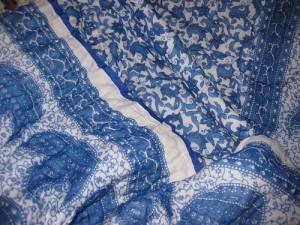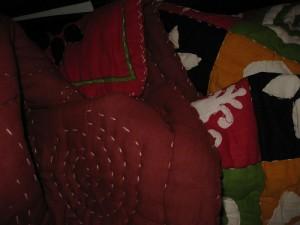
Traditional quilts made by women from Rajasthan are known are razais. Conventionally, razais were made at home from recycled dyed cotton for family use. Colors incorporated on the razais reflect the bright colors of Rajasthan. Bright yellow, red, blue and green are some of the primary colors used in razais. Motifs on razais are flowers, leaves, camels and free hand designs. Razais were used to keep warm during the chilly desert winters. However, now razais have gained popularity owing to the bright colors and motifs and are being marketed all over the world.
Process of cotton carding
Artisans, who make razais, utilize skills such as cotton carding. Preparation of cotton to fill in razais is called cotton carding. This is a traditional skill used by artisans. Two cotton carders are used to make a cotton card. Carders are usually convex with paddles blanketed with fine, small teeth. The carders are changed by filling fibers of cotton into any one carder. The artisan then draws the second carder over the first very gently for a number of times.
The carders’ position changes from horizontal to vertical. The process of cotton carding leads to dross being produced. Dross is waste material that is left behind and it needs to be removed in the carding process. The remaining material after dross removal is fine, delicate and soft cotton fibers. To make a conventional razai, an artisan begins working with 1kilogram of cotton which he works with for a whole week. 100 grams of fine cotton fiber remains after the carding process is complete. The artisan uses this to fill the razai. If the filling of the razai is light and fluffy, the razai tends to be quite warm.

Process of making razais
After the processes of cotton carding and cotton-filling are complete, making the razai is next. An artisan makes sure that the cotton layer is evenly filled throughout the razai. Even layering makes the razai warmer. The outer layer of the razai is made of cotton voile which is soft and of high quality. The softness of the voile gives the razai a smooth surface and makes it lightweight.
Velvet voile is also used to keep up with present day market demands. Once the filling is complete the razai is stitched up. Earlier sewing up the razai was done by a hand held needle. However, now machine needles are used. Machine stitched razais ensure durability. The razai is now complete for use. The bright colors and the motifs on the voile increase the aesthetic value of the razai leading to its global demand.

